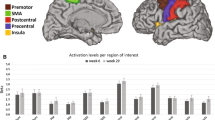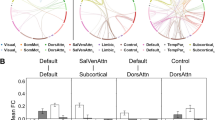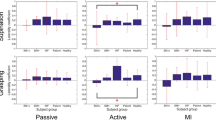Abstract
Electroencephalogram-based brain–computer interfaces (BCI) have been used as a potential tool for training volitional regulation of corticomuscular drive in patients who have severe hemiplegia due to stroke. However, it is unclear whether ERD observed while attempting motor execution can be regarded as a neural marker that represents M1 excitability in survivors of severe stroke. Therefore we investigated the association between ERD and the blood-oxygen-level-dependent (BOLD) fMRI signal during attempted movement of a paralyzed finger in stroke patients. Nine chronic stroke patients received BCI training for finger extension movement 1 h daily for a duration of 1 month. The sensorimotor rhythm was recorded from the sensorimotor area of the damaged hemisphere, and ongoing amplitude variations were monitored using a BCI system. Either a visual alert or the action of a motor-driven orthosis was triggered in response to ERD of the sensorimotor rhythm while patients attempted extension movements of the paralyzed fingers. Inter-subject covariance between ERD and the BOLD response in the sensorimotor areas was calculated. After BCI training, an increased ERD over the damaged hemisphere was confirmed in all participants while they attempted extension of the affected finger and this increase was associated with a BOLD response in primary sensorimotor area. Whole-brain MRI revealed that the primary sensorimotor area and supplementary motor area were activated in the damaged hemisphere after 1 month of BCI training. ERD reflects the BOLD responses of the primary motor areas in either hemisphere while patients who have severe chronic hemiplegia due to a stroke attempt an extension movement of the paralyzed fingers. One month of BCI can alter motor-related brain area activation. Combining BCI with other methods to facilitate such changes may help to implement BCI for motor rehabilitation after stroke.




Similar content being viewed by others
References
Aftanas LI, Varlamov AA, Pavlov SV et al (2002) Time-dependent cortical asymmetries induced by emotional arousal: EEG analysis of event-related synchronization and desynchronization in individually defined frequency bands. Int J Psychophysiol 44:67–82
Ang KK, Guan C, Chua KSG et al (2011) A large clinical study on the ability of stroke patients to use an EEG-based motor imagery brain–computer interface. Clin EEG Neurosci 42:253–258
Arya KN, Pandian S, Verma R, Garg RK (2011) Movement therapy induced neural reorganization and motor recovery in stroke: a review. J Bodyw Mov Ther 15:528–537. doi:10.1016/j.jbmt.2011.01.023
Braun C, Staudt M, Schmitt C et al (2007) Crossed cortico-spinal motor control after capsular stroke. Eur J Neurosci 25:2935–2945
Broetz D, Braun C, Weber C et al (2010) Combination of brain–computer interface training and goal-directed physical therapy in chronic stroke: a case report. Neurorehabil Neural Repair 24:674–679. doi:10.1177/1545968310368683
Buch E, Weber C, Cohen, LG et al (2008) Think to move: a neuromagnetic brain-computer interface (BCI) system for chronic stroke. Stroke 39:910–917. doi:10.1161/STROKEAHA.107.505313
Carey LM, Abbott DF, Egan GF et al (2006) Evolution of brain activation with good and poor motor recovery after stroke. Neurorehabil Neural Repair 20:24–41. doi:10.1177/1545968305283053
Caria A, Weber C, Brötz D et al (2011) Chronic stroke recovery after combined BCI training and physiotherapy: a case report. Psychophysiology 48:578–582. doi:10.1111/j.1469-8986.2010.01117.x
Chino N, Sonoda S, Domen K et al (1994) Stroke Impairment Assessment Set (SIAS). A new evaluation instrument for stroke patients. Jpn J Rehabil Med 31:119–125. doi:10.2490/jjrm1963.31.119
Chollet F, DiPiero V, Wise RJ et al (1991) The functional anatomy of motor recovery after stroke in humans: a study with positron emission tomography. Ann Neurol 29:63–71. doi:10.1002/ana.410290112
Cramer SC, Nelles G, Benson RR et al (1997) A functional MRI study of subjects recovered from hemiparetic stroke. Stroke 28:2518–2527
Daly JJ, Wolpaw JR (2008) Brain–computer interfaces in neurological rehabilitation. Lancet Neurol 7:1032–1043. doi:10.1016/S1474-4422(08)70223-0
Delvaux V, Alagona G, Gérard P et al (2003) Post-stroke reorganization of hand motor area: a 1-year prospective follow-up with focal transcranial magnetic stimulation. Clin Neurophysiol 114:1217–1225
Diciotti S, Gavazzi C, Della Nave R et al (2007) Self-paced frequency of a simple motor task and brain activation. An fMRI study in healthy subjects using an on-line monitor device. Neuroimage 38:402–412. doi:10.1016/j.neuroimage.2007.07.045
Duncan PW, Lai SM, Keighley J (2000) Defining post-stroke recovery: implications for design and interpretation of drug trials. Neuropharmacology 39:835–841
Foltys H, Krings T, Meister IG et al (2003) Motor representation in patients rapidly recovering after stroke: a functional magnetic resonance imaging and transcranial magnetic stimulation study. Clin Neurophysiol 114:2404–2415
Friston K, Holmes A, Worsley K et al (1994) Statistical parametric maps in functional imaging: a general linear approach. Hum Brain Mapp 2:189–210
Halder S, Agorastos D, Veit R et al (2011) Neural mechanisms of brain–computer interface control. Neuroimage 55:1779–1790. doi:10.1016/j.neuroimage.2011.01.021
Hermes D, Vansteensel MJ, Albers AM et al (2011) Functional MRI-based identification of brain areas involved in motor imagery for implantable brain–computer interfaces. J Neural Eng 8:025007. doi:10.1088/1741-2560/8/2/025007
Honaga K, Fujiwara T, Tsuji T et al (2013) State of intracortical inhibitory interneuron activity in patients with chronic stroke. Clin Neurophysiol 124:364–370. doi:10.1016/j.clinph.2012.08.005
Hummel F, Andres F, Altenmüller E et al (2002) Inhibitory control of acquired motor programmes in the human brain. Brain 125:404–420
Jaillard A, Martin CD, Garambois K et al (2005) Vicarious function within the human primary motor cortex? A longitudinal fMRI stroke study. Brain 128:1122–1138. doi:10.1093/brain/awh456
Jørgensen HS, Nakayama H, Raaschou HO et al (1995) Outcome and time course of recovery in stroke. Part II: time course of recovery. The Copenhagen Stroke Study. Arch Phys Med Rehabil 76:406–412
Kaiser V, Daly I, Pichiorri F et al (2012) Relationship between electrical brain responses to motor imagery and motor impairment in stroke. Stroke 43:2735–2740. doi:10.1161/STROKEAHA.112.665489
Levy CE, Nichols DS, Schmalbrock PM et al (2001) Functional MRI evidence of cortical reorganization in upper-limb stroke hemiplegia treated with constraint-induced movement therapy. Am J Phys Med Rehabil 80:4–12
Lopes da Silva F (1991) Neural mechanisms underlying brain waves: from neural membranes to networks. Electroencephalogr Clin Neurophysiol 79:81–93
Lotze M, Cohen LG (2006) Volition and imagery in neurorehabilitation. Cogn Behav Neurol 19:135–140. doi:10.1097/01.wnn.0000209875.56060.06
Mukaino M, Ono T, Shindo K et al (2014) The efficacy of brain–computer interface-driven neuromuscular electrical stimulation for chronic paresis after stroke. J Rehabil Med 46:378–382. doi:10.2340/16501977-1785
Murase N, Duque J, Mazzocchio R, Cohen LG (2004) Influence of interhemispheric interactions on motor function in chronic stroke. Ann Neurol 55:400–409. doi:10.1002/ana.10848
Nakayama H, Jørgensen HS, Raaschou HO, Olsen TS (1994) Recovery of upper extremity function in stroke patients: the Copenhagen Stroke Study. Arch Phys Med Rehabil 75:394–398
Neuper C, Schlögl A, Pfurtscheller G (1999) Enhancement of left-right sensorimotor EEG differences during feedback-regulated motor imagery. J Clin Neurophysiol 16:373–382
Neuper C, Wörtz M, Pfurtscheller G (2006) ERD/ERS patterns reflecting sensorimotor activation and deactivation. Prog Brain Res 159:211–222. doi:10.1016/S0079-6123(06)59014-4
Neuper C, Scherer R, Wriessnegger S, Pfurtscheller G (2009) Motor imagery and action observation: modulation of sensorimotor brain rhythms during mental control of a brain–computer interface. Clin Neurophysiol 120:239–247. doi:10.1016/j.clinph.2008.11.015
Park S-W, Butler AJ, Cavalheiro V et al (2004) Changes in serial optical topography and TMS during task performance after constraint-induced movement therapy in stroke: a case study. Neurorehabil Neural Repair 18:95–105. doi:10.1177/0888439004265113
Pfurtscheller G, Neuper C, Flotzinger D, Pregenzer M (1997) EEG-based discrimination between imagination of right and left hand movement. Electroencephalogr Clin Neurophysiol 103:642–651
Pfurtscheller G, Muller-Putz GR, Scherer R, Neuper C (2008) Rehabilitation with brain–computer interface systems. Computer 41:58–65. doi:10.1109/MC.2008.432
Platz T, Kim I-H, Engel U et al (2002) Brain activation pattern as assessed with multi-modal EEG analysis predict motor recovery among stroke patients with mild arm paresis who receive the Arm Ability Training. Restor Neurol Neurosci 20:21–35
Prasad G, Herman P, Coyle D, et al. (2009) Using motor imagery based brain–computer interface for post-stroke rehabilitation. 4th International IEEE/EMBS Conference on Neural Engineering 2009 NER’09. pp 258 –262
Ramos-Murguialday A, Broetz D, Rea M et al (2013) Brain–machine-interface in chronic stroke rehabilitation: a controlled study. Ann Neurol 74:100–108. doi:10.1002/ana.23879
Sauseng P, Klimesch W, Gerloff C, Hummel FC (2009) Spontaneous locally restricted EEG alpha activity determines cortical excitability in the motor cortex. Neuropsychologia 47:284–288. doi:10.1016/j.neuropsychologia.2008.07.021
Scherer R, Mohapp A, Grieshofer P et al (2007) Sensorimotor EEG patterns during motor imagery in hemiparetic stroke patients. Int J Bioelectromagn 9:155–162
Sharma N, Pomeroy VM, Baron J-C (2006) Motor imagery: a backdoor to the motor system after stroke? Stroke 37:1941–1952. doi:10.1161/01.STR.0000226902.43357.fc
Shindo K, Kawashima K, Ushiba J et al (2011) Effects of neurofeedback training with an electroencephalogram-based brain–computer interface for hand paralysis in patients with chronic stroke: a preliminary case series study. J Rehabil Med 43:951–957. doi:10.2340/16501977-0859
Takemi M, Masakado Y, Liu M, Ushiba J (2013) Event-related desynchronization reflects down-regulation of intracortical inhibition in human primary motor cortex. J Neurophysiol. doi:10.1152/jn.01092.2012
Wang W, Collinger JL, Perez MA et al (2010) Neural interface technology for rehabilitation: exploiting and promoting neuroplasticity. Phys Med Rehabil Clin N Am 21:157–178. doi:10.1016/j.pmr.2009.07.003
Ward N (2011) Assessment of cortical reorganisation for hand function after stroke. J Physiol (Lond) 589:5625–5632. doi:10.1113/jphysiol.2011.220939
Ward NS, Brown MM, Thompson AJ, Frackowiak RSJ (2003) Neural correlates of motor recovery after stroke: a longitudinal fMRI study. Brain 126:2476–2496. doi:10.1093/brain/awg245
Ward NS, Newton JM, Swayne OBC et al (2006) Motor system activation after subcortical stroke depends on corticospinal system integrity. Brain 129:809–819. doi:10.1093/brain/awl002
Ward NS, Newton JM, Swayne OBC et al (2007) The relationship between brain activity and peak grip force is modulated by corticospinal system integrity after subcortical stroke. Eur J Neurosci 25:1865–1873. doi:10.1111/j.1460-9568.2007.05434.x
Wolpaw JR, McFarland DJ (2004) Control of a two-dimensional movement signal by a noninvasive brain–computer interface in humans. Proc Natl Acad Sci USA 101:17849–17854. doi:10.1073/pnas.0403504101
Yuan H, Liu T, Szarkowski R et al (2010) Negative covariation between task-related responses in alpha/beta-band activity and BOLD in human sensorimotor cortex: an EEG and fMRI study of motor imagery and movements. Neuroimage 49:2596–2606. doi:10.1016/j.neuroimage.2009.10.028
Zarkowski P, Shin CJ, Dang T et al (2006) EEG and the variance of motor evoked potential amplitude. Clin EEG Neurosci 37:247–251
Acknowledgments
This study was partially supported by the Strategic Research Program for Brain Sciences (SRPBS) of the Ministry of Education, Culture, Sports, Science, and Technology, Japan.
Disclosures
None
Author information
Authors and Affiliations
Corresponding author
Appendix
Rights and permissions
About this article
Cite this article
Ono, T., Tomita, Y., Inose, M. et al. Multimodal Sensory Feedback Associated with Motor Attempts Alters BOLD Responses to Paralyzed Hand Movement in Chronic Stroke Patients. Brain Topogr 28, 340–351 (2015). https://doi.org/10.1007/s10548-014-0382-6
Received:
Accepted:
Published:
Issue Date:
DOI: https://doi.org/10.1007/s10548-014-0382-6




